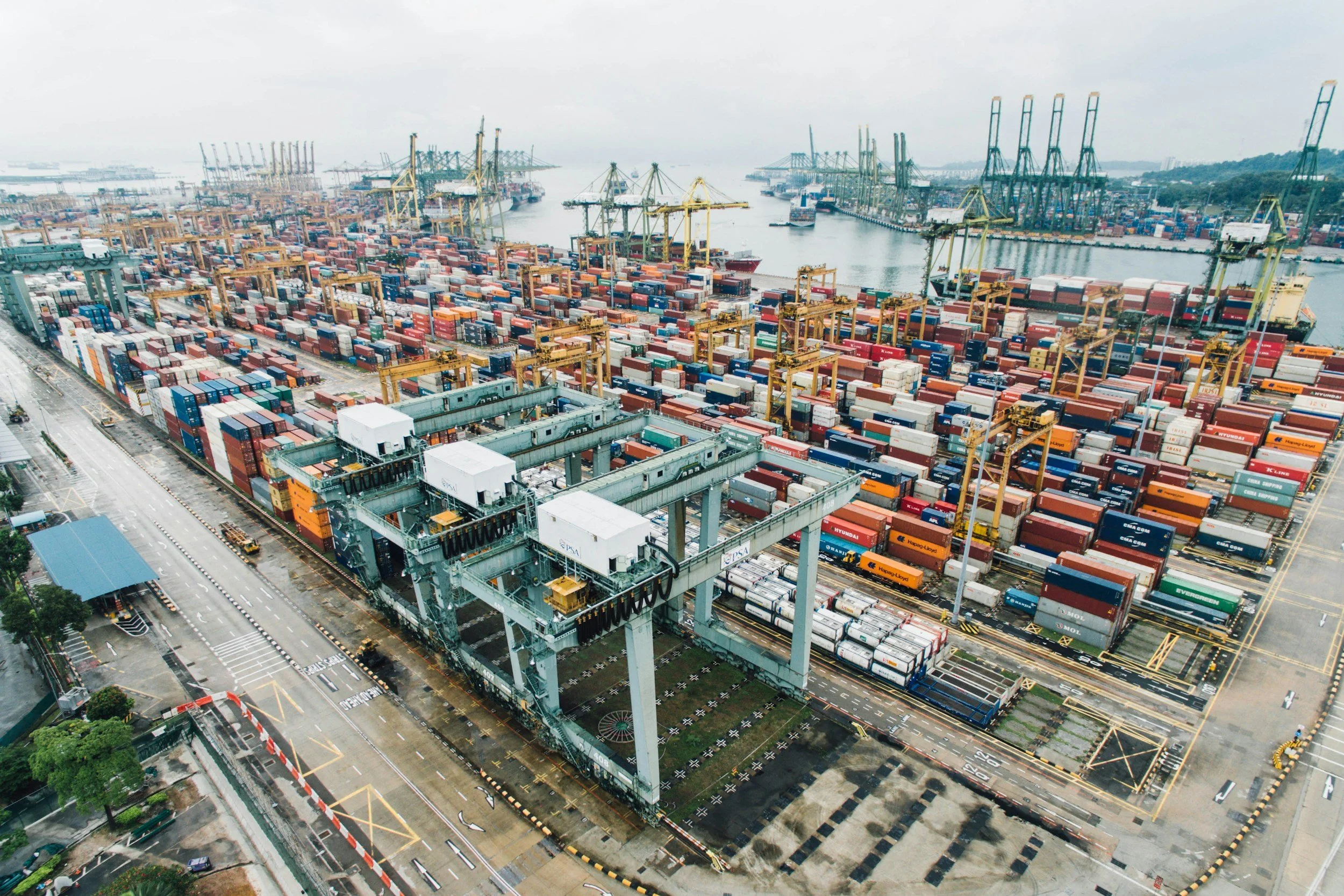Industry Insights: Ram Ganesh Kamatham from the Sustainable Shipping Initiative
In the Industry Insights blogpost series, we sit down with each SASHA member to find out what drives them in their work and what challenges they face.
Here we speak to Ram Ganesh Kamatham, Head of Programmes at SASHA’s knowledge partner the Sustainable Shipping Initiative (SSI), a non-profit convening industry members from across the maritime ecosystem to advance decarbonising shipping.
Ram Ganesh Kamatham, Head of Programmes at the Sustainable Shipping Initiative
SASHA isn’t the only coalition bringing industry actors together to drive decarbonisation. Since 2010, the SSI has been convening organisations across the maritime value chain to support the industry’s passage towards a green future.
Speaking to Ram Ganesh Kamatham made clear just how expansive his role as Head of Programmes must be. The SSI’s holistic approach cuts no corners, coordinating companies from mainstream shipowners to sustainable hull painters, engaging businesses, NGOs and international bodies, and working across topics from fuels to finance, oceans to energy, spanning land, sea and sky with its focus on emissions, people, communities and biodiversity.
Biodiversity and the shipping industry
“It was two years ago that a recognition arose within the SSI membership that ocean ecosystems were not being given much of a priority,” Ram Ganesh reflects on the beginning of SSI’s interest in biodiversity. “Everybody was focusing very heavily on decarbonisation, which is still the main point of sustainable investment, while biodiversity continues to be relatively underfunded.” Identifying this gap sparked SSI’s project of confronting the links between the ‘triple planetary crises’ of climate change, pollution and biodiversity as they pertain to shipping.
Two years of stakeholder engagement led to the launch of SSI’s oceans roadmap at COP29. While part of SSI’s focus overlaps with the SASHA Coalition’s eye for biodiversity risks in fuel production pathways, Ram Ganesh explains that “the SSI focuses on the maritime stakeholder’s angle”, including issues such as black carbon in the Arctic, bilge water, and marine invasive species.
Delving into these issues with its membership, SSI identified scope for co-benefits where industry changes can reduce emissions and biodiversity impacts at the same time. “Voyage planning is one example,” says Ram Ganesh. “Effective planning of your ship’s route could burn less fuel and avoid certain species’ migratory patterns, for example to reduce whale strikes.”
Sustainable Shipping Initiative (SSI) member meeting
Collaboration and coalitions for climate
The voyage planning solution is indicative of effective facilitation on the part of the SSI. “The conversation started with the idea of ‘slow steaming’ to reduce emissions, but there was pushback from the industry saying that slowing down voyages may cut emissions per vessel, but could also lead to more ships in the water.” Research shows that reducing ships’ speed by 10-20% can lead to a 13-24% reduction in emissions. While this most impactful result was not taken up, Ram Ganesh explains how the discussion led to parties arriving at an alternative approach to voyage planning that included just-in-time arrival at ports and integrated marine spatial planning as an alternative, tackling climate and biodiversity concerns in tandem.
Another intervention Ram Ganesh mentions with co-benefits for climate and biodiversity is enhancing propellers to increase energy efficiency and lower emission intensity, while also reducing underwater noise.
It's no easy business, but the point of departure, as Ram Ganesh understands it, is “setting a science-aligned baseline understanding for good practice, convening the right set of people in the room, and then trying to find consensus.” He continues, “it's not perfect though, because once you get into policy design, other considerations come into play.”
Ram Ganesh points again to slow steaming as an example. “It has benefits from a scientific standpoint, but once you get into policy design you see that while you might see achievements for individual ships or units, you may create completely different outcomes at the fleet level.” Industry engagement is the key to pre-empting unintended adverse impacts of decarbonisation policy, and ensuring policies are tightened to achieve the desired results.
The benefits of voyage planning are already tangible, as Ram Ganesh recounts an anecdote of an SSI member who rerouted ships off the coast of Sri Lanka to avoid a major whale migration route, eliciting a significant reduction in strikes. Another achieved similar outcomes at the Port of Vancouver.
“There will always be bad actors and laggards,” he says. “But we have first movers who are taking very strong, ambitious positions. Those need to be highlighted and rewarded. This is where the SSI membership is quite remarkable.”
Achieving these wins depends on the diversity of the voices in the room, and SSI’s membership convene companies along with other stakeholders including NGOs. Collaboration between these diverse parties has resulted in what Ram Ganesh calls a ‘positive ambition loop’. Rather than just reach an impasse on a particular topic, he explained that working group sessions with “the right inputs from NGOs and policy discussions, along with coffee and post-it notes, result in industry arriving at holistic and integrated sustainability targets.”
Noting the parallel between SSI and SASHA’s own wide-stakeholder approach, Ram Ganesh continues, “partnering and collaborating within and outside of the shipping sector is essential to advance and accelerate shipping’s energy transition. This is why SSI sees the SASHA coalition as a key facilitator in this endeavour, joined as a knowledge partner.”
Sustainable Shipping Initiative (SSI) members meeting
Multilateralism and maritime first movers
With the International Maritime Organization (IMO) having just approved measures to cut shipping’s greenhouse gas (GHG) emissions, the discussion of the new regulatory landscape it’s created for international shipping is unavoidable.
Ram Ganesh believes the regulations did not meet the mark, but stand as an important start nonetheless. "While the recent IMO decisions taken at MEPC 83 don't go as far as we see is necessary, it is nevertheless an outcome that establishes a strong foundation for the further regulation of global emissions in shipping.” Following the decision the SASHA Coalition commented that incentives are not as strong as they could have been and expected revenues from the pricing mechanism will not suffice to adequately reward early adopters of zero and near zero fuels, nor ensure the transition is just and equitable.
One point of optimism for Ram Ganesh is the lifecycle emission accounting of fuels. “Addressing lifecycle emissions, we are encouraged by the steps to be taken to ensure a robust certification of fuels by a recognised Sustainable Fuels Certification Scheme (SFCS).” The SFCS was approved at MEPC 83, and the IMO will publish a list of recognised SFCSs by 1 March 2027.
SSI previously played a major role in informing IMO emissions accounting policy. In 2021, SSI and the Copenhagen Business School – Maritime adopted 15 principles for evaluating marine fuels that incorporate environmental, social and economic sustainability concerns. The guidelines’ foundation is a lifecycle analysis (LCA), or Well-to-Wake (WtW) methodology, to assess fuels based on emissions released not just at the point of combustion but also upstream including in production, transport and storage, in line with the best available science.
Sustainability criteria of fuels infographic, Sustainable Shipping Initiative (SSI)
“These principles were eventually taken up by the IMO to develop their LCA guidelines,” Ram Ganesh says, “it was a big success that we were able to feed into the IMO process and the shift towards well-to-wake coverage. It’s crucial that sustainability remains central to decision-making,” he continues, “embedding such principles at the core of fuel standards ensures that decarbonisation efforts are both environmentally sound and socially responsible.”
Outside the IMO, SSI continues to engage with the UN Marrakech Partnership, including at COP. Here, Ram Ganesh says, the SSI’s knack for multistakeholder convening is instrumental for accelerating change beyond its membership at the macro level.
At COP, the recent strategy has been to convene industry stakeholders who have made voluntary commitments towards biodiversity and GHG emission reductions. It’s only through their active participation here that “ambition levels can be raised and businesses will make the right investment decisions early so that sustainability is prioritised,” he says. “It's about rewarding first movers who have gone on the front foot to make certain commitments towards change.”
Ambitious first-mover companies’ influence goes beyond the limits of their fleets. “Sending unambiguous and urgent demand signals for low and zero carbon future fuels, such as for hydrogen-derived fuels is key,” Ram Ganesh says, recognising companies’ role in promoting alternative fuel production. “The SASHA Coalition provides an important platform to demonstrate the demand for green hydrogen, by bringing the shipping and aviation industries together to lay clear the crucial role it has to play.”
Investment decisions taken now ripple far into the future. As with all big industries – those that are usually trickiest to decarbonise – assets have long life cycles. Ram Ganesh explains, “a car will have a life of 10-12 years, , but a ship has a lifetime of 15-30 years.” This means many of the decisions being stalled by uncertainty today will have impacts three decades down the line.
It is precisely here that policy intervention and the ambition of bold first movers are so important, not least those in the SSI (and SASHA for that matter) memberships. Ram Ganesh quotes an SSI member as saying, “uncertainty cannot be the basis for not taking any decisions, as the risk of not acting is usually greater.”
If uncertainty breeds indecision, the opposite is also true, and with big industry actors taking bold moves along with policy shifts on the horizon set to create some certainty as to the industry’s direction, momentum may start to build. “It’s a virtuous cycle when first movers inspire innovation and change, and we celebrate them, and then fast followers accelerate progress,” says Ram Ganesh. “We focus on helping the ambitious first movers set the direction for the rest of the industry and highlight what's good and what others can model and emulate.”
Find out more about the Sustainable Shipping Initiative here. The views expressed here do not necessarily reflect those of the wider SASHA Coalition.
















